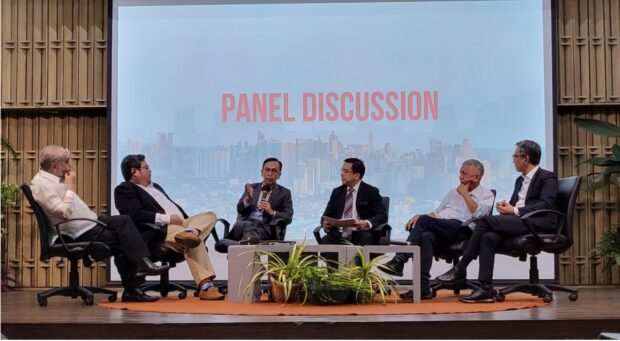
AboitizPower Head of Energy Transition Projects Lino Bernardo (third from left) discusses the priorities in helping the country pursue a robust nuclear power program during the second Ruperto P. Alonzo Memorial Lecture held at the University of the Philippines School of Economics, Diliman.
The Philippine nuclear program should prioritize safety while striving to make prices competitive via quality planning and a sound regulatory environment, an Aboitiz Power Corporation (AboitizPower) official said.
“Number one, nuclear energy has to be safe, full stop. At the same time, it has to be reliable and affordable,” said AboitizPower Head of Energy Transition Projects Felino Bernardo, noting that the lifespan of a nuclear power plant — which can last from 40 to 60 years — factors into its levelized cost of electricity (LCOE).
LCOE measures the cost of building and operating a power plant to determine the needed average revenue per unit of electricity generated.
“Nuclear has a different kind of economics, with high capital expenditures (CapEx) and low running costs,” Bernardo explained. “But these are just the CapEx and running costs. We’re not yet talking about externalities like impact to the environment, to health, and to supporting the growing share of intermittent sources in the electricity grid. We have to take all these into consideration.”
Bernardo made his remarks during the second Ruperto P. Alonzo Memorial Lecture entitled “The Nuclear Option” held at the University of the Philippines School of Economics, Diliman.
The executive added that a major driver of cost in building nuclear power plants concerns interest rates and whether or not construction is on time and on budget.
“Significant delays, combined with high-interest rates, will make a nuclear project uneconomic. It really depends on the quality of planning, the strength of the supply chain, and the regulatory environment,” he said.
Bernardo said that policy would ultimately determine the desired energy mix of technologies as it relates to balancing energy security, energy affordability, and environmental issues and safety, with the latter being the main responsibility of the proposed nuclear regulatory body.
Electricity demand is projected to increase by 6.6 percent annually until 2040. Simultaneously, the Philippine government targets to transition the power grid to have 50 percent renewable energy by the same year.
Nuclear power is seen as a zero-emissions baseload complement to the growth of variable renewable energy. A capacity of 1,200 megawatts from nuclear power is targeted to take part in the Philippine power mix by 2032, according to the Department of Energy.
“Energy is very important. Economic growth is highly correlated with the growth in capacity in electricity,” Bernardo said, emphasizing the need for sufficient supply to meet demand and sustain economic growth.
“We also need to ensure affordability but at the same time encourage development by investors with the appropriate policies,” he added.
The Philippine economy grew by 5.6 percent in 2023. The country targets an economic growth rate of 6.5-7.5 percent for 2024 and 6.5-8 percent for 2025 to 2028. S&P Global also projects the Philippines to have a trillion-dollar economy by 2033.
“It has to be a managed transition,” Bernardo maintained. “It is a big challenge to achieve this balance and we need both the public and private sectors’ cooperation to make it happen.”
READ: New projects sustain company confidence, says AboitizPower CFO